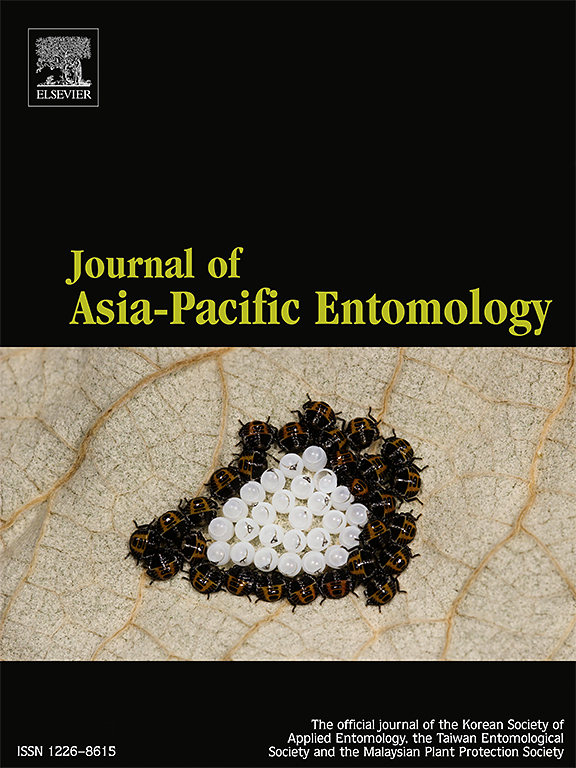Histopathological and biochemical efficacy of some entomopathogenic nematodes on the greater wax moth, Galleria melonella larvae (Lepidoptera: Pyralidae)
IF 1.3
3区 农林科学
Q3 ENTOMOLOGY
引用次数: 0
Abstract
The penetration rates of four entomopathogenic nematode (EPN) strains Heterorhabditis bacteriophora (HP88), Steinernema carpocapsae (Sc), Steinernema glaseri (Sg), and Steinernema scapterisci (Ss) were evaluated on last-instar larvae of Galleria mellonella at three concentrations: 20, 50, and 100 infective juveniles (IJ) per larva. Results showed a positive correlation between penetration rate and nematode concentration, with significant differences among strains (P < 0.001). The highest cumulative penetration rates were observed with H. bacteriophora (HP88), ranging from 0.79 ± 0.02 IJ/larva at 20 IJ to 0.98 ± 0.03 IJ/larva at 100 IJ. S. carpocapsae ranged from 0.45 ± 0.03 to 0.83 ± 0.06 IJ/larva, while S. scapterisci had the lowest penetration, from 0.32 ± 0.06 to 0.55 ± 0.03 IJ/larva. Histopathological examination revealed damage to the larvae’s body wall, including disintegration of the cuticular layer, epidermis dissolution, and nematode tunnels in the body cavity. Defense responses, such as hemocyte presence, were observed. Biochemical analysis showed increased acid phosphatase (ACP) after most treatments and alkaline phosphatase (ALP) activities, with acetylcholinesterase (AChE) varying among treatments. Phenoloxidase activity was elevated in all treated larvae. These findings suggest that EPNs, especially H. bacteriophora, are effective against G. mellonella and may be promising biological control agents.

几种昆虫病原线虫对大蜡蛾幼虫的组织病理学和生化效果研究
研究了4种昆虫病原线虫(EPN)在20、50和100个感染幼虫(IJ)浓度下,对嗜菌异芽线虫(Heterorhabditis bacteriophora, HP88)、carpocapsae斯坦内菌(steinerma carpocapsae, Sc)、glaseri斯坦内菌(steinerma glaseri, Sg)和scapterisci斯坦内菌(steinerma scapterisci, Ss)对mellonella Galleria末龄幼虫的渗透率。结果表明,穿透率与线虫浓度呈正相关,菌株间差异显著(P <;0.001)。嗜菌杆菌(HP88)的累积穿透率最高,20 IJ时为0.79±0.02 IJ/幼虫,100 IJ时为0.98±0.03 IJ/幼虫。油菜蠹蛾的渗透范围为0.45±0.03 ~ 0.83±0.06 IJ/幼虫,油菜蠹蛾的渗透范围为0.32±0.06 ~ 0.55±0.03 IJ/幼虫。组织病理学检查显示幼虫体壁损伤,包括角质层解体、表皮溶解和体腔内的线虫隧道。观察到防御反应,如血细胞的存在。生化分析表明,大部分处理后酸性磷酸酶(ACP)和碱性磷酸酶(ALP)活性均有所升高,不同处理间乙酰胆碱酯酶(AChE)活性差异较大。所有处理的幼虫酚氧化酶活性均升高。这些结果表明EPNs,特别是嗜杆菌H.对大蜡杆菌具有较好的防治效果,可能是一种很有前景的生物防治剂。
本文章由计算机程序翻译,如有差异,请以英文原文为准。
求助全文
约1分钟内获得全文
求助全文
来源期刊

Journal of Asia-pacific Entomology
Agricultural and Biological Sciences-Insect Science
CiteScore
2.70
自引率
6.70%
发文量
152
审稿时长
69 days
期刊介绍:
The journal publishes original research papers, review articles and short communications in the basic and applied area concerning insects, mites or other arthropods and nematodes of economic importance in agriculture, forestry, industry, human and animal health, and natural resource and environment management, and is the official journal of the Korean Society of Applied Entomology and the Taiwan Entomological Society.
 求助内容:
求助内容: 应助结果提醒方式:
应助结果提醒方式:


